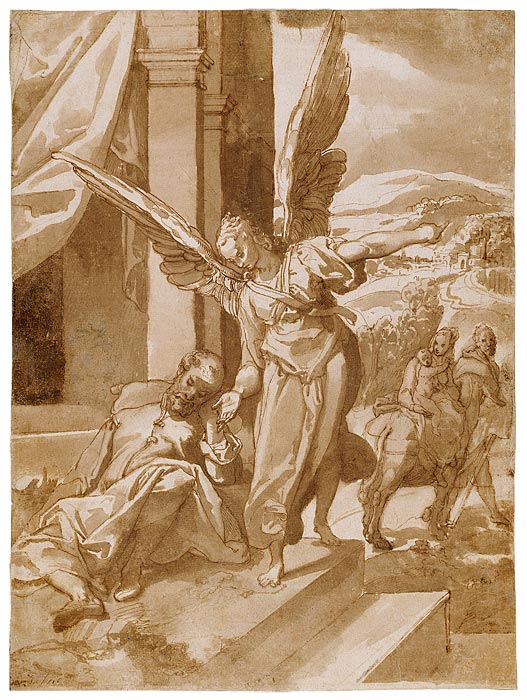(Italian, Codemondo near Reggio Emilia 1550–1578 Rome)
The Apparition of the Angel to St. Joseph, ca. 1576
Pen and brown ink and brown wash, over red chalk
15 x 11 1/8 inches (381 x 282 mm)
Inscribed at lower left, in pen and brown ink, Zuchero.
Purchased in honor of Charles E. Pierce, Jr.'s tenure as director by the Visiting Committee to the Department of Drawings and Prints through the generosity of Ildiko Butler, Diane A. Nixon, Andrea Woodner, Hamilton Robinson, Jr., Joan Taub Ades, Clement C. Moore II, Jayne Wrightsman, David M. Tobey, Eugene V. Thaw, George L.K. Frelinghuysen, Seymour and Helen Mae Askin, Catherine G. Curran, Melvin R. Seiden, Hubert and Mireille Goldschmidt, and Wheelock Whitney III; 2007.80 A native of Reggio Emilia, the Late Mannerist painter Raffaellino is said to have arrived in Rome during the pontificate of Gregory XIII (1572–85) or possibly somewhat earlier, and spent the rest of his brief career there. By the time he drew the Dream of St. Joseph, Raffaellino had worked as Giovanni de' Vecchi's assistant on the frescoes in the Villa Farnese at Caprarola (ca. 1574) and was working independently on the Loggia of Pope Gregory XIII in the Vatican Palace (1575–1577), the Oratorio del Gonfalone, and his only known oil painting, the Tobias and the Angel in the Galleria Borghese. Both Raffaellino's paintings and drawings reveal him to have been a close follower of Taddeo Zuccaro. This recent acquisition is a late compositional study for the fresco The Apparition of the Angel to St. Joseph, painted around 1576 on the vault of the Orsini (later Ghislieri) Chapel in the church of San Silvestro al Quirinale in Rome, still extant today. It differs from the fresco in minor details. In the painted version, for instance, the wings of the angel are lowered, whereas in the drawing they are upright. In addition, the secondary biblical episode of the Flight into Egypt has been moved further back in pictorial space; thus in the fresco the warning to Joseph to flee Herod, communicated by an angel appearing in a dream as recounted in the Gospel of Matthew (2:13), more emphatically dominates the composition.
A native of Reggio Emilia, the Late Mannerist painter Raffaellino is said to have arrived in Rome during the pontificate of Gregory XIII (1572–85) or possibly somewhat earlier, and spent the rest of his brief career there. By the time he drew the Dream of St. Joseph, Raffaellino had worked as Giovanni de' Vecchi's assistant on the frescoes in the Villa Farnese at Caprarola (ca. 1574) and was working independently on the Loggia of Pope Gregory XIII in the Vatican Palace (1575–1577), the Oratorio del Gonfalone, and his only known oil painting, the Tobias and the Angel in the Galleria Borghese. Both Raffaellino's paintings and drawings reveal him to have been a close follower of Taddeo Zuccaro. This recent acquisition is a late compositional study for the fresco The Apparition of the Angel to St. Joseph, painted around 1576 on the vault of the Orsini (later Ghislieri) Chapel in the church of San Silvestro al Quirinale in Rome, still extant today. It differs from the fresco in minor details. In the painted version, for instance, the wings of the angel are lowered, whereas in the drawing they are upright. In addition, the secondary biblical episode of the Flight into Egypt has been moved further back in pictorial space; thus in the fresco the warning to Joseph to flee Herod, communicated by an angel appearing in a dream as recounted in the Gospel of Matthew (2:13), more emphatically dominates the composition.
Plan your visit. 225 Madison Avenue at 36th Street, New York, NY 10016.
Plan your visit. 225 Madison Avenue at 36th Street, New York, NY 10016.
Raffaellino Motta da Reggio
By Rhoda Eitel-Porter
Wednesday, February 14, 2007
Blog cateogry
